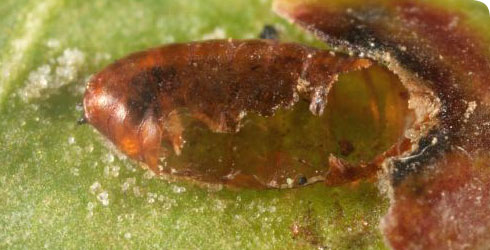Biology
There is a single generation per year.
In May or June the adult female fly lays its eggs singly in the underside of the petiole or midrib of a young leaf, leaving a clear scar. During the following months, the larva tunnels in the midrib in the direction of the leaf tip.
In December or January the larva enters the leaf blade, where the first moult takes place. The larva then makes a large blotch in the leaf-blade. Most frass is deposited in the centre of the blotch, and the epidermis often turns wine red.
The larvae spend the winter months feeding within the leaf and then pupate in spring within the mine with the anterior spiracles of the pupa penetrating the epidermis of the leaf. Adults emerge in spring through a semi-circular slit cut in the epidermis.
Mines with circular exit holes usually indicate that the larva had been parasitised.
Known parasitoids include the chalicidoid wasps:
- Chrysocharis gemma
- Chrysocharis pentheus
- Chrysocharis pubicornis
- Pediobius metallicus
- Cyrtogaster vulgaris
- Sphegigaster pallicornis
Find out more about these species by searching the Universal Chalcidoidea Database.
Life cycle
This video illustrates the biology of a related species of agromyzid fly, the South American leaf miner Liriomyza huidobrensis, cleaning, feeding, and egg laying. It also shows the life history from egg to adult fly.
Liriomyza huidobrensis life-cycle video - YouTube
The South American leaf miner is a highly polyphagous pest of ornamental and vegetable crops and is occasionally intercepted at UK points of entry.
Glossary
Frass
Debris produced by burrowing insects.
Mesonotum
The upper surface of the middle segment of the thorax.
Petiole
The stalk of a leaf.
Spiracles
Openings that allow gas exchange in insects.
